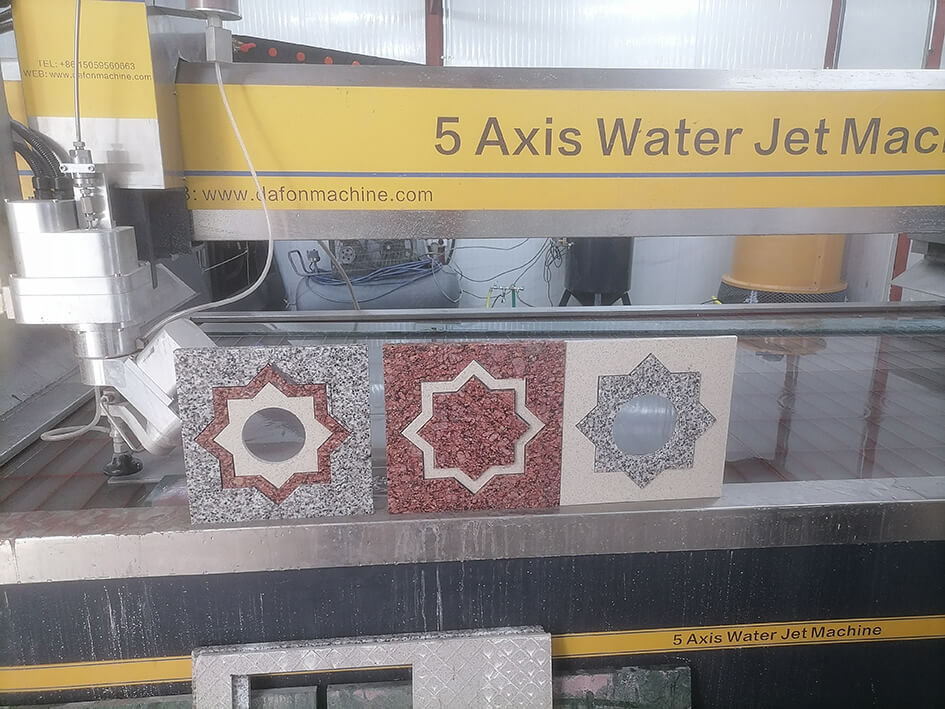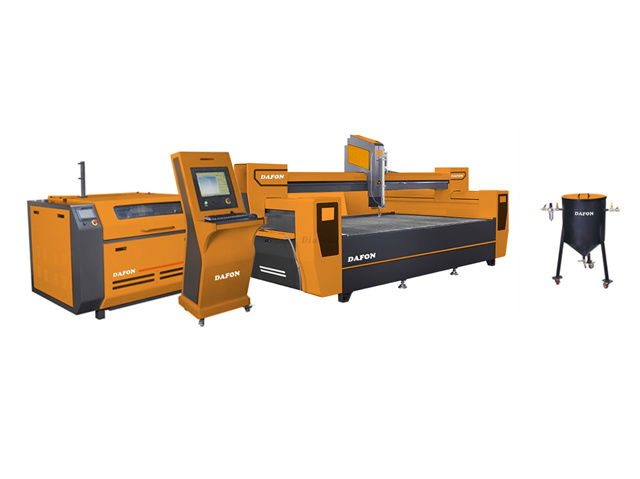Author:Dafon Kerbstone Machine FROM:Stone Machine Manufacturer TIME:2024-08-08
A waterjet machine uses a high-pressure stream of water, often mixed with abrasive materials, to cut through various materials with precision. This technology is highly versatile and capable of cutting a wide range of materials, including:
· Stone: Granite, marble, slate, and other natural stones.
· Metals: Steel, aluminum, titanium, copper, and more.
· Glass: Both plain and tempered glass.
· Ceramics: Tiles and ceramic parts.
· Composites: Carbon fiber, fiberglass, and other composite materials.
· Plastics: Acrylics, polycarbonates, and other plastic materials.
· Foam and Rubber: Various types of foam and rubber materials
The cutting thickness of a waterjet machine depends on several factors, including the type of material, the pressure of the waterjet, and whether or not an abrasive is used. Here are some general guidelines for different materials:
Water Pressure: Higher pressure increases the cutting ability. Typical waterjet systems operate at pressures between 30,000 and 90,000 PSI.
Abrasive Use: Adding abrasive materials like garnet to the waterjet stream enhances the cutting capability, especially for hard materials like metal and stone.
Machine Power and Design: More powerful and advanced machines can handle thicker materials more efficiently.
Cutting Speed: Slower cutting speeds can allow for cutting thicker materials, though this increases processing time.
Material type: Harder materials like steel require more cutting power than softer materials like wood or plastic. (Granite and Marble: Typically up to 6-8 inches (150-200 mm) thick, though thicker cuts are possible with more powerful machines and proper abrasive selection.)
Cutting head technology: Advancements in cutting head design can increase cutting depth.

Waterjet machines are incredibly versatile and can cut through a wide range of materials, but there are some limitations. Here's a more detailed look at what waterjet machines can and cannot cut:
Materials Waterjet Machines Can Cut:
Metals, Stone( Granite, marble, slate, and other natural stones.), Glass, Ceramics, Composites, Plastics, Foam and Rubber, Wood, Food etc.
don't cut:
Certain Brittle Materials: Very brittle materials may crack or shatter under the high-pressure water jet, especially if they have existing flaws or are not supported properly.
Thick Materials: While waterjets can cut very thick materials, there are practical limits. Extremely thick materials may require multiple passes or specialized equipment.
Soft Materials: Very soft and flexible materials, like certain foams, can be difficult to cut cleanly because they may deform under the pressure of the water jet.
Overall, waterjet machines are one of the most versatile cutting tools available, capable of cutting a vast array of materials with high precision and minimal material deformation.

The cost comparison between waterjet and laser cutting depends on several factors, including the type and thickness of the material being cut, the complexity of the cut, operational costs, and the specific requirements of the project. Here are some key points to consider when comparing the costs of waterjet and laser cutting:
Waterjet Cutting Costs:
Initial Investment: Waterjet machines tend to be more expensive to purchase and set up compared to laser cutting machines.
Operational Costs: Higher operational costs due to the need for water, abrasive materials (like garnet), and regular maintenance of high-pressure components.
Material Versatility: Can cut a wider variety of materials, including very thick and reflective materials, which might save costs in multi-material operations.
Speed and Efficiency: Slower cutting speeds compared to laser cutting, especially for thin materials, can result in higher labor and machine operation costs.
Laser Cutting Costs:
Initial Investment: Generally, laser cutting machines have a lower initial cost compared to waterjet machines, especially for CO2 lasers. Fiber lasers, however, can be more expensive.
Operational Costs: Lower operational costs as they do not require abrasives and use less energy than waterjets. However, maintenance of the laser optics and periodic replacement of laser sources can add to costs.
Material Limitations: Limited in cutting certain materials, particularly thick metals and reflective materials like aluminum and copper, which can lead to the need for additional cutting methods or machines.
Speed and Efficiency: Higher cutting speeds for thin materials and lower thicknesses, resulting in faster turnaround times and potentially lower labor costs.
Summary:
Waterjet Cutting: Higher initial and operational costs, better for thicker materials and a wider variety of materials, slower cutting speeds.
Laser Cutting: Lower initial and operational costs for thin materials, faster for thin materials, limited in cutting very thick or reflective materials.
The choice between waterjet and laser cutting should be based on the specific requirements of your project, including material type and thickness, cut quality, speed, and overall budget. For many applications, the long-term operational costs and efficiencies will be the deciding factors.

Laser cutter and waterjet have their own advantages and disadvantages, and the following factors affect the choice:
Material type and thickness: Waterjet excels with thick materials and various types, while laser is better for thinner materials and certain types like acrylic.
Desired cut quality: Laser generally provides cleaner cuts, while waterjet leaves a rougher edge.
Speed: Laser is faster for thin materials, but waterjet can be comparable for thicker ones.
Cost: Initial investment is typically lower for waterjet, but operating costs can be higher.
Environmental impact: Laser cutting can produce fumes, while waterjet uses water and abrasives.
In summary:
Choose a laser cutter if: you need high precision, fast cutting speeds for thin materials, clean cuts, and versatility.
Choose a waterjet if: you need to cut thick materials, complex shapes, or materials that can't be laser cut, and material integrity is crucial.
Often, the best approach is to combine both technologies to leverage their respective advantages.
The cost of a waterjet cutter can vary widely based on several factors, including the machine's capabilities, size, brand, and features. Generally, here are some price ranges for different types of waterjet cutters:
Entry-level waterjet cutters: These are smaller, less powerful machines suitable for hobbyists or small businesses. Prices typically range from $30,000 to $60,000.
Mid-range waterjet cutters: These machines offer more power, larger cutting areas, and better precision, making them suitable for small to medium-sized manufacturing operations. Prices usually range from $60,000 to $150,000.
High-end waterjet cutters: These are advanced machines with large cutting areas, high precision, and additional features such as multiple cutting heads or integrated software. They are ideal for large manufacturing operations and can cost anywhere from $150,000 to $500,000 or more.
Specialized or custom waterjet cutters: Depending on specific requirements, such as cutting very thick materials or needing additional automation features, the cost can exceed $500,000.
In addition to the initial purchase price, consider the following ongoing costs:
Maintenance and consumables (such as abrasives and nozzles)
Energy consumption
Training for operators
Installation and setup fees
Advantages of Water Jet Cutting
Versatility: Water jet cutters can cut a wide range of materials, including metals, ceramics, stone, glass, composites, and plastics. They are particularly useful for materials sensitive to high temperatures.
No Heat-Affected Zone (HAZ): Since water jet cutting is a cold cutting process, it eliminates heat distortion and the risk of altering the material properties that can occur with laser or plasma cutting.
Precision and Accuracy: Water jet cutters can achieve high precision, typically within ±0.1 mm, making them suitable for intricate and detailed designs.
Minimal Material Waste: The narrow kerf (cutting width) of water jet cutting reduces material waste, making it a cost-effective option for expensive materials.
Environmentally Friendly: Water jet cutting produces no hazardous fumes, gases, or vapors. The water and abrasive used can often be recycled.
No Need for Secondary Finishing: The high-quality finish of water jet cuts often eliminates the need for secondary finishing processes, saving time and cost.
Disadvantages of Water Jet Cutting
Higher Operating Costs: The cost of consumables (such as abrasives) and the maintenance required for high-pressure pumps can be significant.
Slower Cutting Speed: Compared to other cutting methods like laser or plasma cutting, water jet cutting can be slower, especially for thicker materials.
Complex Setup and Maintenance: Water jet cutters can be complex to set up and maintain, requiring skilled operators and regular maintenance.
Large Footprint: Water jet cutting machines can take up significant space in a workshop, which might be a constraint for smaller facilities.
Limited Thickness for Certain Materials: While water jets can cut a variety of materials, their efficiency decreases with extremely thick materials. For very thick metals, other cutting methods might be more appropriate.
Water and Abrasive Disposal: Proper disposal of used water and abrasive materials is necessary to comply with environmental regulations, adding to the operational complexity.